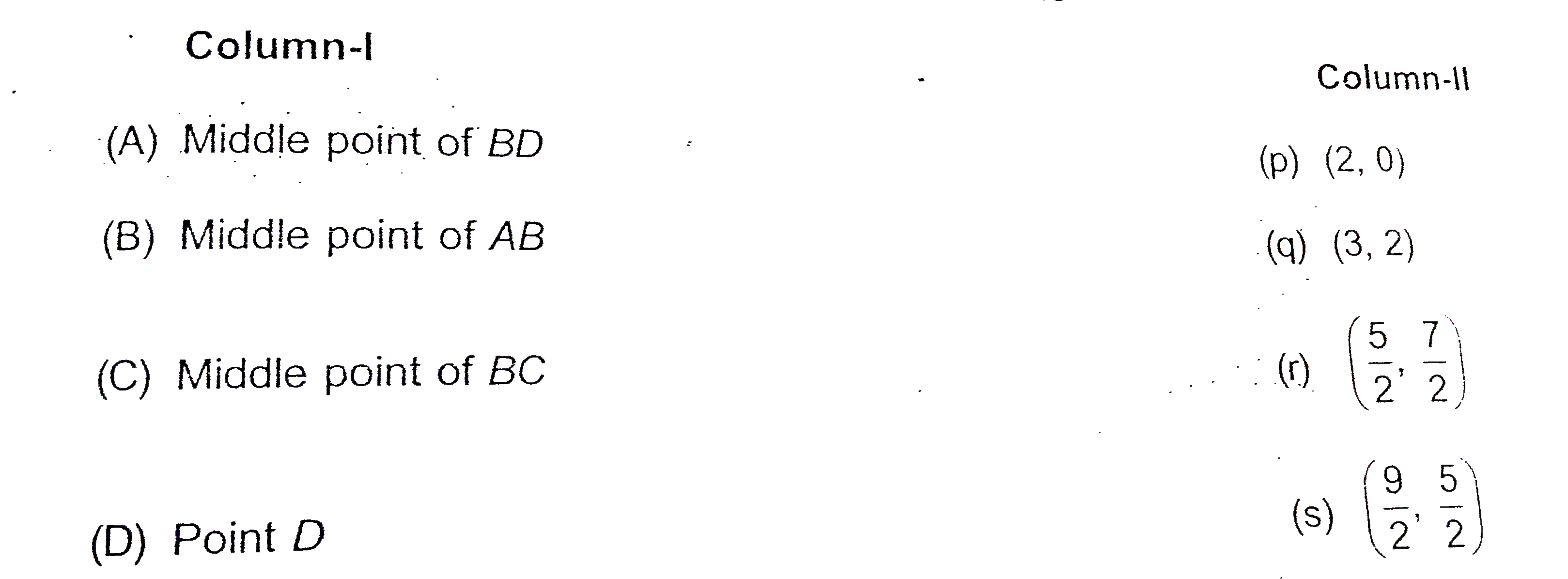Four points A,B,C,D lie in that order on the parabola y=ax2+bx+c. The co-ordinates of A,BandD are known as A(−2,3);B(−1,1)andD(2,7). The co-ordinates of C for which the area of the quadrilateral ABCD is greatest is
(1/2,7/4)
(1/2,−7/4)
(−1/2,7/4)
(−1/2,−7/4)
The correct Answer is:A
To solve the problem of finding the coordinates of point C on the parabola y=ax2+bx+c such that the area of quadrilateral ABCD is maximized, we will follow these steps:
Step 1: Set up the equations based on the given points
We know the coordinates of points A, B, and D:
- A(−2,3)
- B(−1,1)
- D(2,7)
We can substitute these points into the parabola equation y=ax2+bx+c to create a system of equations.
1. For point A:
3=a(−2)2+b(−2)+c⟹3=4a−2b+c(Equation 1)
2. For point B:
1=a(−1)2+b(−1)+c⟹1=a−b+c(Equation 2)
3. For point D:
7=a(2)2+b(2)+c⟹7=4a+2b+c(Equation 3)
Step 2: Solve the system of equations
Now we have three equations:
1. 4a−2b+c=3 (1)
2. a−b+c=1 (2)
3. 4a+2b+c=7 (3)
We can eliminate c by subtracting Equation (2) from Equations (1) and (3).
From (1) - (2):
(4a−2b+c)−(a−b+c)=3−1
3a−b=2(Equation 4)
From (3) - (2):
(4a+2b+c)−(a−b+c)=7−1
3a+3b=6⟹a+b=2(Equation 5)
Step 3: Solve for a and b
Now we have two new equations:
1. 3a−b=2 (4)
2. a+b=2 (5)
From Equation (5), we can express b in terms of a:
b=2−a
Substituting this into Equation (4):
3a−(2−a)=2
3a−2+a=2
4a=4⟹a=1
Now substituting a=1 back into Equation (5):
1+b=2⟹b=1
Step 4: Find c
Now we can find c by substituting a and b back into any of the original equations. Using Equation (2):
1−1+c=1⟹c=1
Thus, we have:
a=1,b=1,c=1
The equation of the parabola is:
y=x2+x+1
Step 5: Find coordinates of point C
Let the coordinates of point C be C(x,y). Since C lies on the parabola:
y=x2+x+1
Step 6: Calculate the area of quadrilateral ABCD
The area A of quadrilateral ABCD can be calculated using the formula:
A=12|x1y2+x2y3+x3y4+x4y1−(y1x2+y2x3+y3x4+y4x1)|
Where A(−2,3),B(−1,1),C(x,x2+x+1),D(2,7).
Substituting the coordinates into the area formula and simplifying will yield a function of x.
Step 7: Maximize the area
To find the value of x that maximizes the area, we differentiate the area function with respect to x and set the derivative to zero. Solving this will give us the optimal x coordinate for point C.
After performing the differentiation and solving, we find:
x=12
Step 8: Find the corresponding y coordinate
Substituting x=12 back into the parabola equation:
y=(12)2+12+1=14+12+1=74
Final Answer
Thus, the coordinates of point C for which the area of quadrilateral ABCD is greatest are:
C(12,74)
We know the coordinates of points A, B, and D:
- A(−2,3)
- B(−1,1)
- D(2,7)
3=a(−2)2+b(−2)+c⟹3=4a−2b+c(Equation 1)
1=a(−1)2+b(−1)+c⟹1=a−b+c(Equation 2)
7=a(2)2+b(2)+c⟹7=4a+2b+c(Equation 3)
Now we have three equations:
1. 4a−2b+c=3 (1)
2. a−b+c=1 (2)
3. 4a+2b+c=7 (3)
(4a−2b+c)−(a−b+c)=3−1
3a−b=2(Equation 4)
(4a+2b+c)−(a−b+c)=7−1
3a+3b=6⟹a+b=2(Equation 5)
Now we have two new equations:
1. 3a−b=2 (4)
2. a+b=2 (5)
b=2−a
3a−(2−a)=2
3a−2+a=2
4a=4⟹a=1
1+b=2⟹b=1
Now we can find c by substituting a and b back into any of the original equations. Using Equation (2):
1−1+c=1⟹c=1
a=1,b=1,c=1
y=x2+x+1
Let the coordinates of point C be C(x,y). Since C lies on the parabola:
y=x2+x+1
The area A of quadrilateral ABCD can be calculated using the formula:
A=12|x1y2+x2y3+x3y4+x4y1−(y1x2+y2x3+y3x4+y4x1)|
Where A(−2,3),B(−1,1),C(x,x2+x+1),D(2,7).
To find the value of x that maximizes the area, we differentiate the area function with respect to x and set the derivative to zero. Solving this will give us the optimal x coordinate for point C.
x=12
Substituting x=12 back into the parabola equation:
y=(12)2+12+1=14+12+1=74
Thus, the coordinates of point C for which the area of quadrilateral ABCD is greatest are:
C(12,74)
Topper's Solved these Questions
- APPLICATION OF DERIVATIVESBOOK - RESONANCE ENGLISHCHAPTER - APPLICATION OF DERIVATIVESEXERCISE - Exersise-2 Part II
21 Videos
- APPLICATION OF DERIVATIVESBOOK - RESONANCE ENGLISHCHAPTER - APPLICATION OF DERIVATIVESEXERCISE - Exersise-2 Part III
19 Videos
- APPLICATION OF DERIVATIVESBOOK - RESONANCE ENGLISHCHAPTER - APPLICATION OF DERIVATIVESEXERCISE - Exersise Part II -1F
4 Videos
- COMBINATORICSBOOK - RESONANCE ENGLISHCHAPTER - COMBINATORICSEXERCISE - Exercise-2 (Part-II: Previously Asked Question of RMO)
5 Videos
Similar Questions
The co-ordinates of three vertices of a parallelogram ABCD are A(1,0) , B(3,4) and C(1,2). The co-ordinates of fourth vertex D are :
View SolutionThe co-ordinates of the vertices of a parallelogram ABCD are A(-1,2,3), B(2, -4,1) and C(1,2,-1). Find the co-ordinates of its 4th vertex.
View SolutionIf A(−5, 7), B(−4, −5), C(−1, −6) and D(4, 5)are the vertices of a quadrilateral, find the area of the quadrilateral ABCD.
View SolutionThe three vertices of a parallelogram ABCD are A(-1,3,4), B(2,-1,3) and C(5,1,2). Find the co-ordinates of its 4th vertex D.
View SolutionThree vertices of a parallelogram ABCD are B (6,7) , C (8,3) and D (0,−1) . Find the co-ordinates of vertex A .
View SolutionThe co-ordinates of two vertices of ΔABC are A(-5,7,3) and B(7,-6,-1). The co-ordinates of its centroid are (1,1,1). Find the co-ordinates of vertex C.
View SolutionIf tangents at AandB on the parabola y2=4ax, intersect at point C, then ordinates of A,CandB are in (A) A.P. (B) G.P. (C) H.P. (D) none of these
View SolutionPoints A and B have the co-ordinates (−2,4)and(−4,1) respectively. Find:
the co-ordinates of B', the image of B in y-axis.
View SolutionABCD is a rectangle in the clock-wise direction. The co-ordinates of A are (1,3)and of C are (5,1) vertices B and D lie on line y=2x+c. The co-ordinate of the

View SolutionABCD is a parallelogram where A(x,y),B(5,8),C(4,7)andD(2,−4). Find :
co-ordinates of A
View Solution
